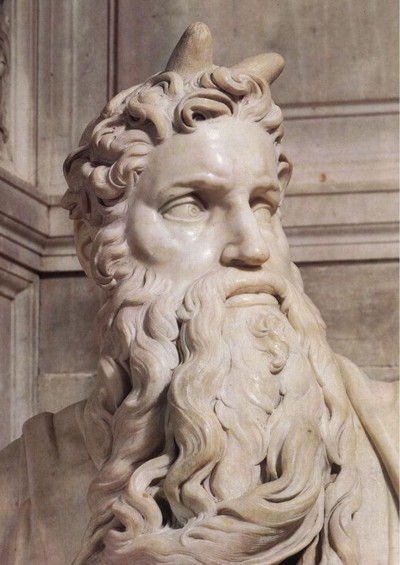
Michelangelo. Moisés. 1513-1515. Pormenor.
English Русский Lietuvių
Apačioje yra pateikta keletas pavyzdžių, parodančių, kaip krikščioniška
Bažnyčia vaizduoja Mozę su ragais.
| http://tendimag.com/2014/12/02/um-par-de-cornos/ |
 Michelangelo. Moisés. 1513-1515. Pormenor. |
| Um par de cornos |
| http://tendimag.com/2014/12/02/um-par-de-cornos/ |
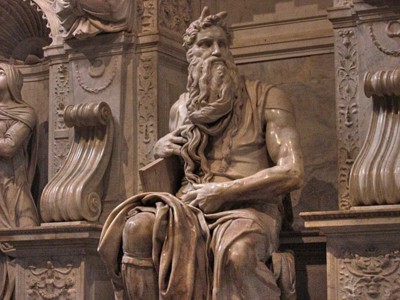 Michelangelo. Moisés. 1513-1515 |
| Um par de cornos |
| http://tendimag.com/2014/12/02/um-par-de-cornos/ |
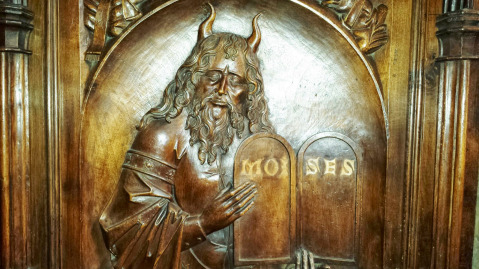 Moisés. Sillería de coro de la catedral de San Salvador de Oviedo. Obra realizada entre 1491 y 1497. |
| Um par de cornos |
| http://tendimag.com/2014/12/02/um-par-de-cornos/ |
 Statue of Moses c.1150-1200, St. Mary’s Abbey, now in the Yorkshire Museum. Detail. |
| Um par de cornos |
| http://tendimag.com/2014/12/02/um-par-de-cornos/ |
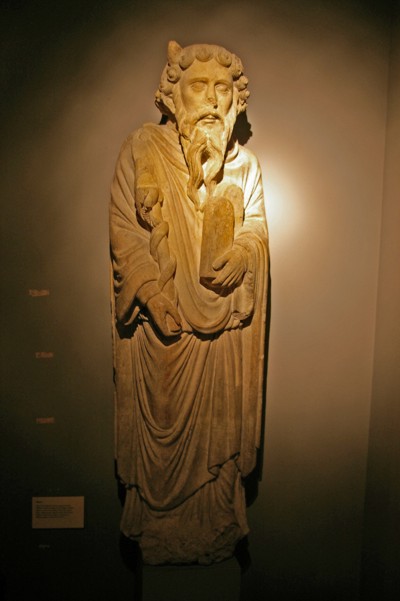 Statue of Moses c.1150-1200, St. Mary’s Abbey, now in the Yorkshire Museum. |
| Um par de cornos |
| http://tendimag.com/2014/12/02/um-par-de-cornos/ |
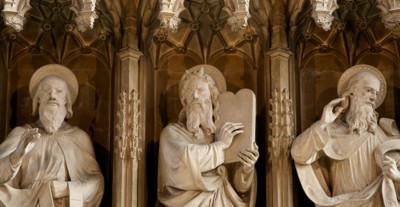 Moses with Horns in the Chapel at New College, Oxford. 1350. |
| Um par de cornos |
| http://tendimag.com/2014/12/02/um-par-de-cornos/ |
 Moses with Horns in the Chapel at New College, Oxford. 1350. Pormenor. |
| Um par de cornos |
| http://tendimag.com/2014/12/02/um-par-de-cornos/ |
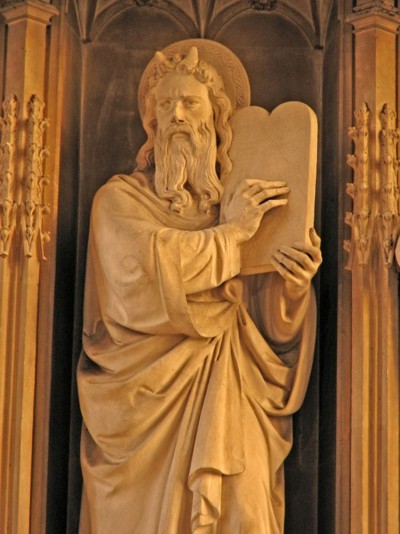 Moses with Horns in the Chapel at New College, Oxford. 1350. Pormenor. |
| Um par de cornos |
| http://tendimag.com/2014/12/02/um-par-de-cornos/ |
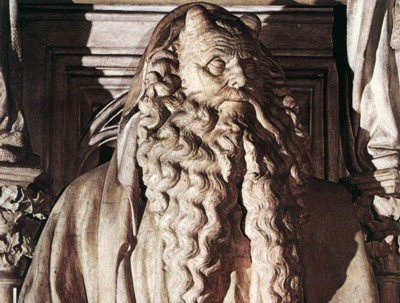 Claus Sluter, Well of Moses. 1395-1403. Musée Archéologique, Dijon |
| Um par de cornos |
| http://tendimag.com/2014/12/02/um-par-de-cornos/ |
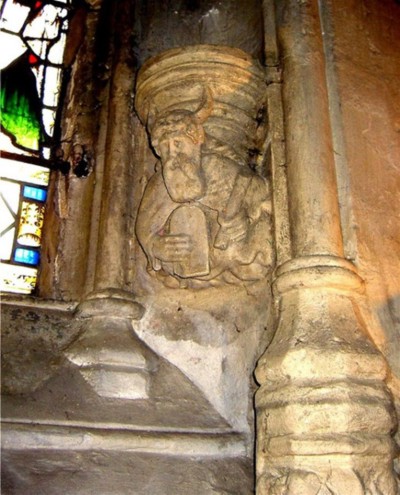 Janela da Capela de Rosslyn (construída ente 1446 e 1484). Moisés. |
| Um par de cornos |
| http://tendimag.com/2014/12/02/um-par-de-cornos/ |
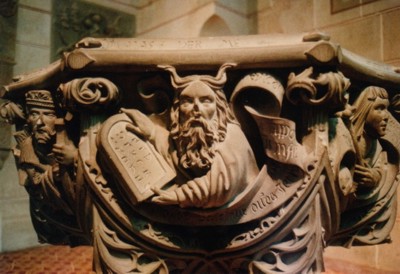 Moses on the 1518 baptismal font in St. Amandus, Bad Urach, Germany, by the sculptor Christoph von Urach. |
| Um par de cornos |
| http://tendimag.com/2014/12/02/um-par-de-cornos/ |
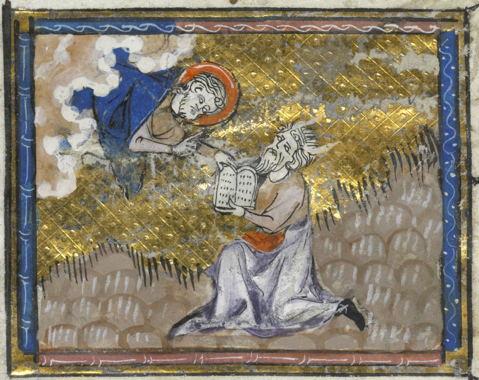 Moisés recebe as tábuas da lei. Ms. Rouen, BM 0.4. Séc. XIV. |
| Um par de cornos |
| http://tendimag.com/2014/12/02/um-par-de-cornos/ |
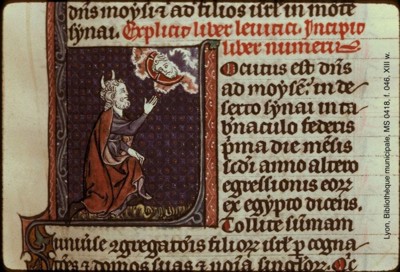 Lyon, Bibliothèque Municipale. Ms a418. séc XIII |
| Um par de cornos |
| http://tendimag.com/2014/12/02/um-par-de-cornos/ |
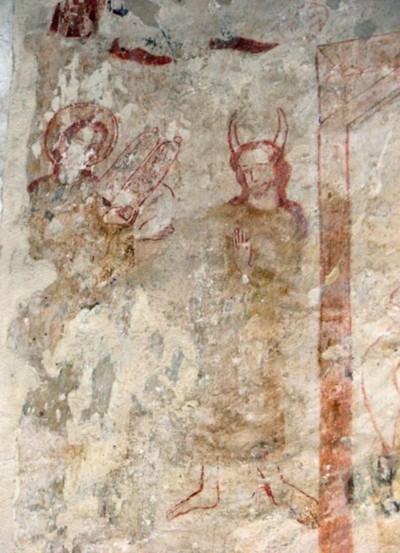 Fresco medieval. Deus dá a tábua dos dez mandamentos a Moisési. St. Andrews Church in Westhall. |
| Um par de cornos |
| http://tendimag.com/2014/12/02/um-par-de-cornos/ |
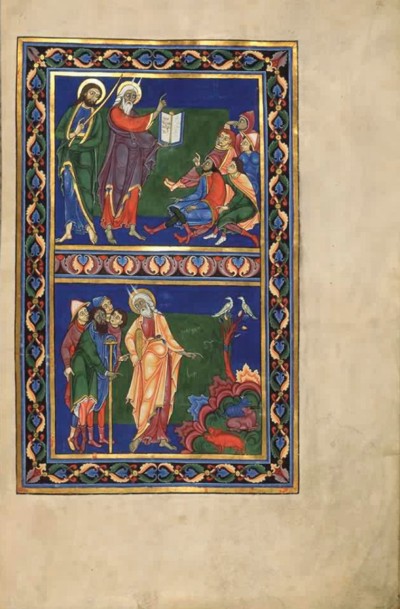 Bury Bible (about 1355). Cambridge |
| Um par de cornos |
| http://tendimag.com/2014/12/02/um-par-de-cornos/ |
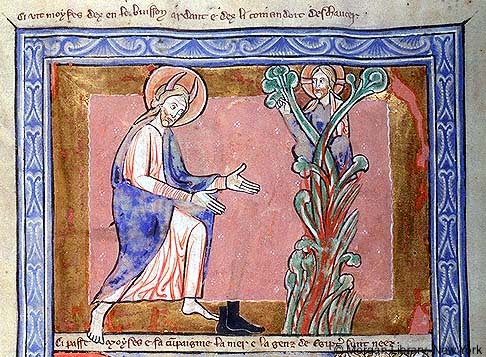 Arbusto flamejante. Huntingfield Psalter. 1210-1220. |
| Um par de cornosPPPP |
| http://tendimag.com/2014/12/02/um-par-de-cornos/ |
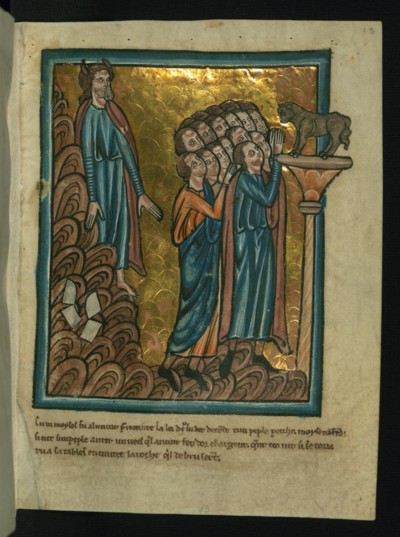 William de Brailes. The Israelites Worship the Golden Calf and Moses Breaks the Tablets. circa 1250 |
| Um par de cornos |
| http://tendimag.com/2014/12/02/um-par-de-cornos/ |
 Andrea de Bonaiuto (1333-1392), Moisés. Afresco (detalhe) |
| Um par de cornos |
| http://tendimag.com/2014/12/02/um-par-de-cornos/ |
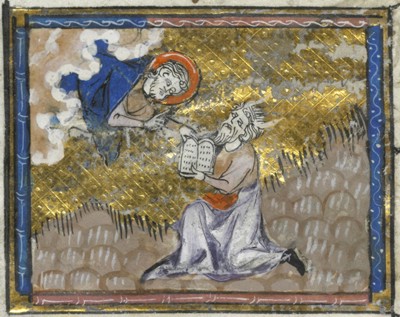 Moisés recebe as tábuas da lei. Ms. Rouen, BM 0.4. Séc. XIV. |
| Um par de cornos |
| http://tendimag.com/2014/12/02/um-par-de-cornos/ |
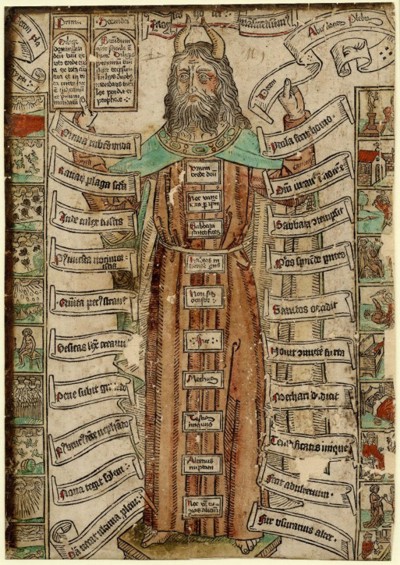 Moses, the ten plagues and the ten commandments. 1465-1480. The British Museum. |
| Um par de cornos |
| http://schistory.net/springsofgrace3/devotional/Moses/moseswithhornsonthecolonnadellimmacolata.html |
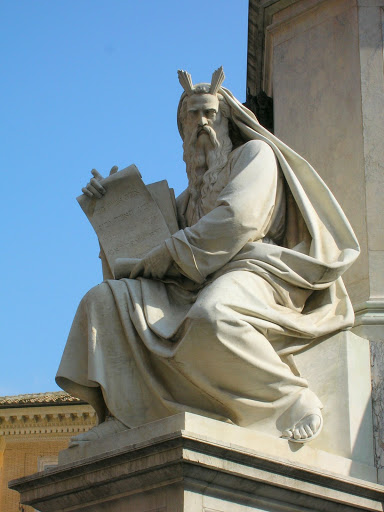 Moses, with horns, on the Colonna dell'Immacolata The “horns” were originally a mis-translation of the beams of light eminating from his head after receiving the ten commandments. The horns continued to be used, however, due to the fact that it is easier to sculpt horns than light beams. |
| |
| https://maggielr.wordpress.com/2011/05/17/509/ |
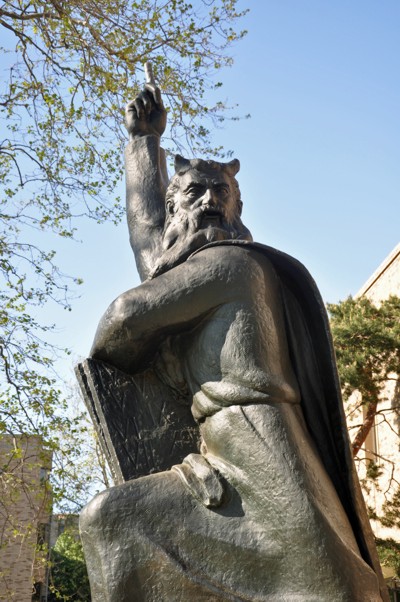
|
| From the Lake to Moses May 17, 2011 |
| http://daysontheclaise.blogspot.com/2011/09/usse-chapel-wood-carvings.html |
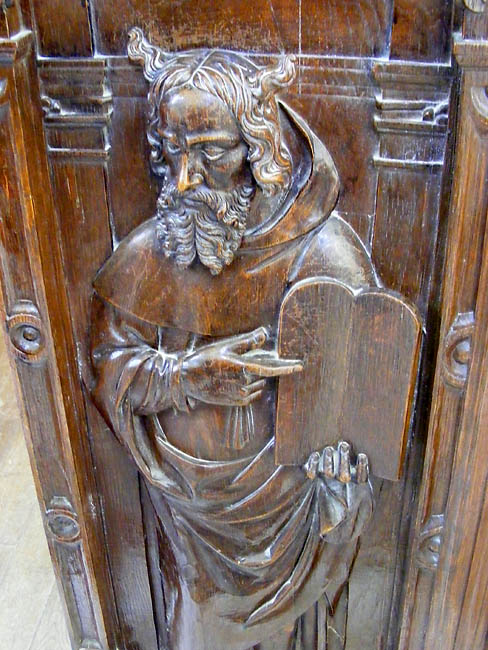 The 16th century carvings on the pews in the 'new' chapel at the Château d'Ussé are well worth looking at. Fine carving in both wood and stone is a feature of this Renaissance private chapel. |
| Ussé Chapel Wood Carvings 3 September 2011 |
| http://www.firstchurchoftheinternet.org/studies/moses.htm |
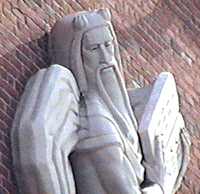 Joseph Kiselewski's 1965 terracotta Moses |
| Look at Moses forehead. He has horns! Why? |
| http://pascasher.blogspot.com/2009/02/gilad-atzmon-pas-casher.html |
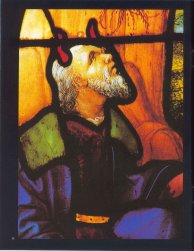 Detail of Moses with horns from one of the Windows of Arnaud de Moles' in Auch Cathedral, France. |
| Gilad Atzmon 05 April 2008 |
| |
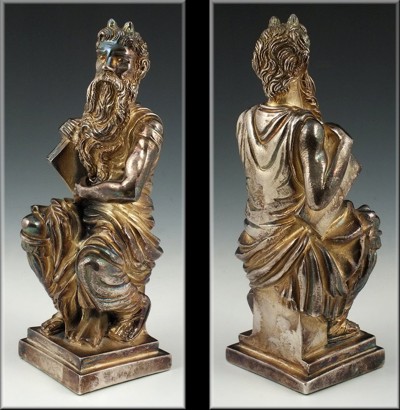
|
| |
| |
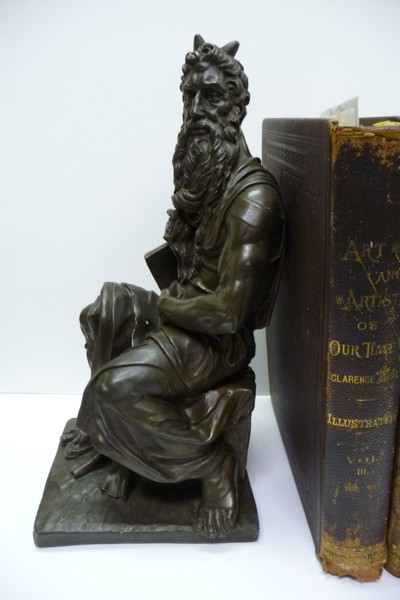
|
| |
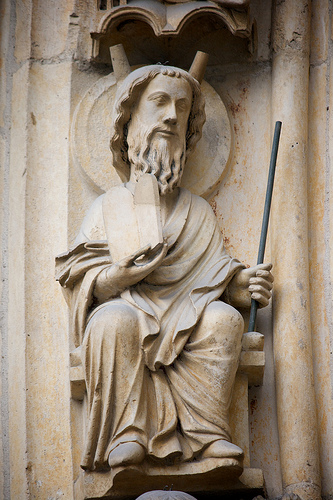 |
| |
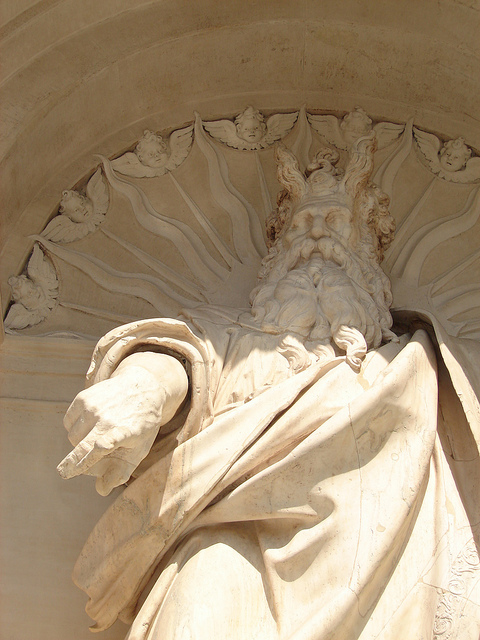 |
| |
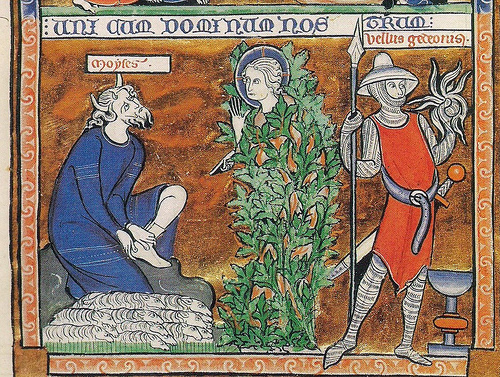 |
| http://thriceholy.net/vulgate.html |
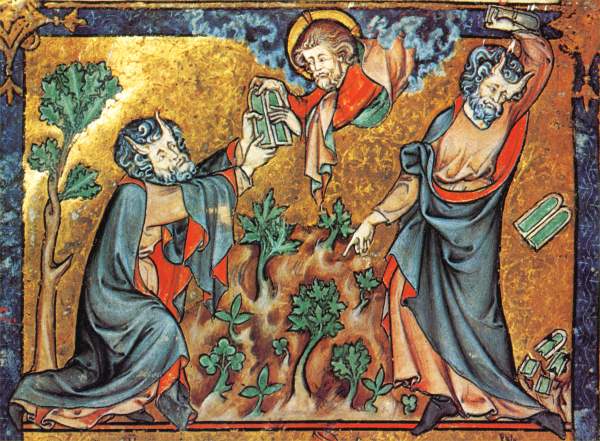 La Somme le Ray, Honore Moses Why does this man have horns?: Because: "And when Moses came down from the Mount Sinai, he held the two tables of the testimony, and he knew not that his face was horned from the conversation of the Lord. And Aaron and the children of Israel seeing the face of Moses horned, were afraid to come near...And they saw that the face of Moses when he came out was horned [cornutam Vulgate], but he covered his face again, if at any time he spoke to them." (Exodus 34:29-35, Douay-Rheims). |
| The Vulgate |
| http://stowaweigh.com/page/2/ |
 The 12th century Romanesque naves and transept of the Collegiate Church prompt many whispered oohs and ahhs. The intricately-carved 13th century Gothic wooden choir holds panels depicting Biblical scenes. Do they need another bass voice here? At one end stands a sculpted Moses, tablets in hand, with horns on his head—like Michelangelo’s sculpture. The horns come from the mis-translation of a Torah passage from Hebrew into Latin in the 4th century. Above the panels, there’s still more: lifelike carvings of people and putti. |
| Vienna Woods July 20, 2011 |
| http://www.brogilbert.org/gods/2gods_hebrews.htm |
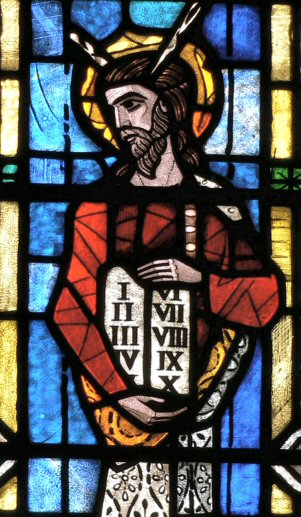 |
| Journey Toward One God |
| http://www.whale.to/c/moses.html |
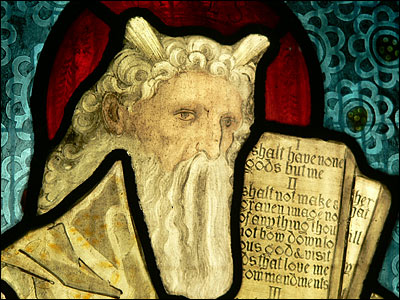 |
| http://www.liveinternet.ru/users/madam_halina/post267112407/ https://weepingredorger.wordpress.com/2012/08/21/bern-switzerland/ |
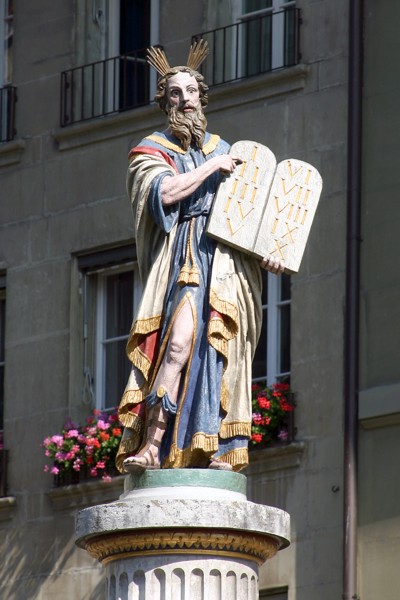
|
| Моисей с десятью заповедями Mosesbrunnen — Фонтан Моисея расположен на Соборной площади (восстановлен в 1790-91 годах). Фонтан украшает статуяМоисея с Десятью Заповедями, которые он несет людям. Moses’ Fountain Moses fountain Moses fountain The Moses fountain, located on Münsterplatz (Cathedral Plaza) was rebuilt in 1790–1791. The Louis XVI style basin was designed by Niklaus Sprüngli. The Moses figure dates from the 16th century. The statue represents Moses bringing the Ten Commandments to the Tribes of Israel. Moses is portrayed with two rays of light projecting from his head, which represent Exodus 34:29–35 which tells that after meeting with God the skin of Moses’ face became radiant. The twin rays of light come from one longstanding tradition that Moses instead grew horns. |
| http://my-albion.blogspot.com/2011/07/like-those-who-read-medusas-mazeful.html |
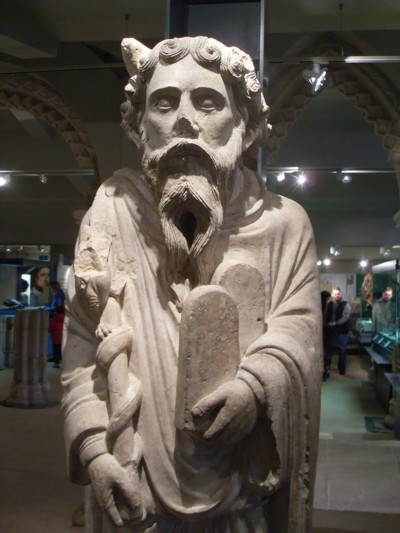 And it came to pass, when Moses came down from mount Sinai with the two tables of testimony in Moses' hand, when he came down from the mount, that Moses wist not that the skin of his face shone while he talked with him. - Exodus, 34:29 The above passage was falsely translated from Hebrew into Latin by Jerome, so in the Vulgate Moses was depicted as having horns. This came about because the similarity between the Hebrew word for "shining" or "resplendent" and the word for "horns". |
| Like those who read Medusa's
mazeful hea 30. juli 2011 |
| |
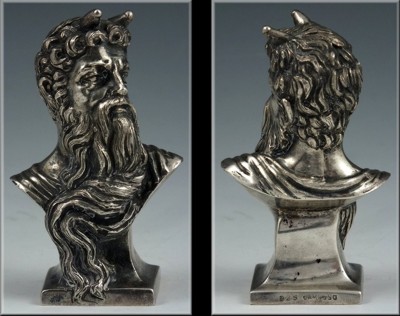
|
| http://xemandrios1.blogspot.com/2011/11/el-shaddai-wikipedia.html |
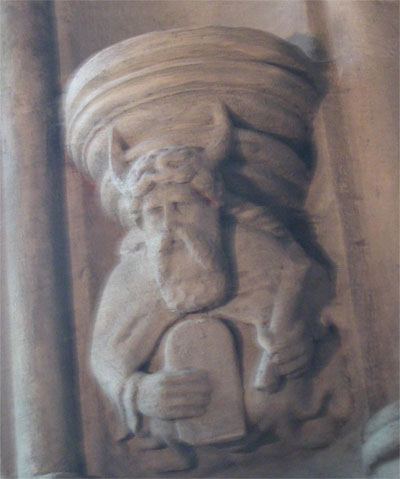 |
| Ορίστε ποιος ειναι ο Ελ Σεντάι ή El Shaddai του Λιακόπουλου... ξεσκέπασμα της απάτης και από wikipedia. |
| http://schistory.net/springsofgrace3/devotional/Moses/claussluterwellofmoses13951406limestonesculpturefrench.html |
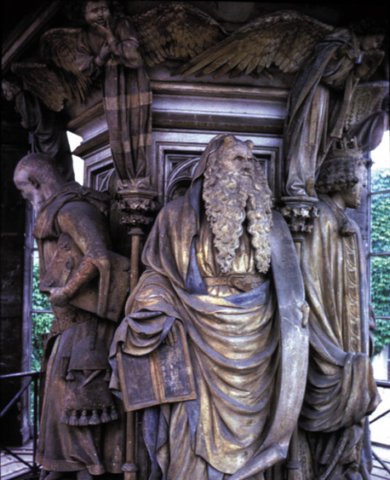 Claus Sluter, Well of Moses, 1395-1406. limestone sculpture. French. |
| |
| |
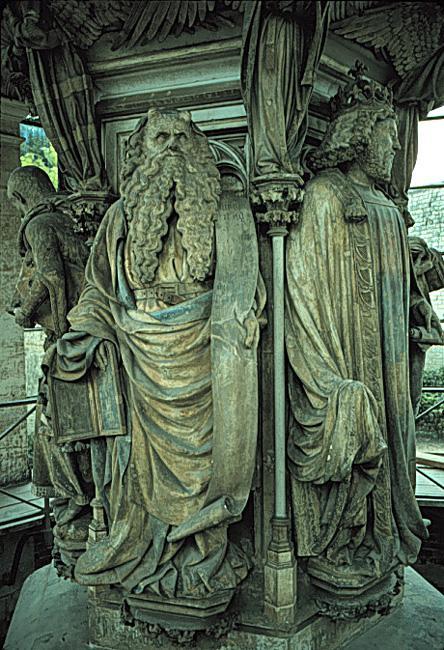 |
| |
| |
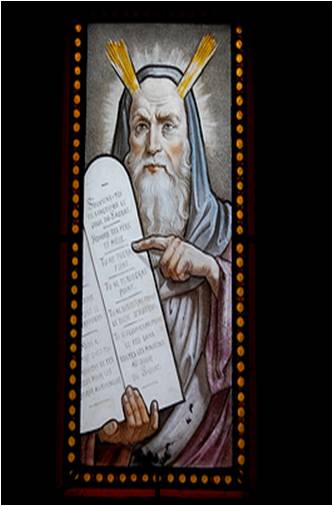 |
| https://www.flickr.com/photos/barkingtigs/7387797162/ |
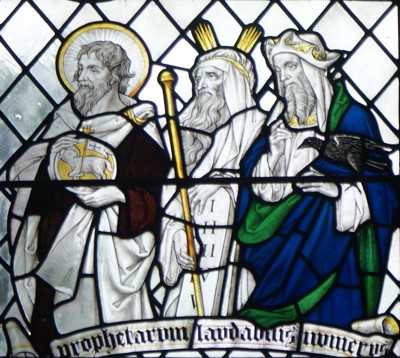 St John the Bapist;Moses;Elijah A close up of some the prophets in the Te Deum window in St Andrew's, Marks Tey. It shows (left to right) St John the Baptist (with the Lamb of God); Moses (with horns !); Elijah (with Raven). The latin text at the bottom is "te prophetarum laudailis numerus" - "the wonderful company of the prophets". Colchester Borough, England, United Kingdom |
| |
| http://boards.straightdope.com/sdmb/showthread.php?t=622974 |
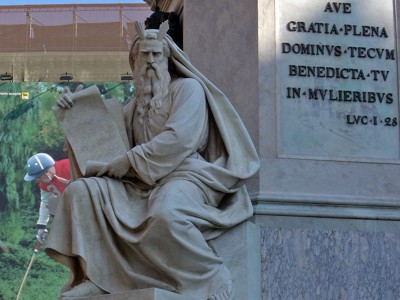
|
| Straight Dope Message Board > Main > In My Humble Opinion (IMHO) > Did any American in the past 50 years ever really think that Jews have horns? |
| http://www.whale.to/c/moses.html |
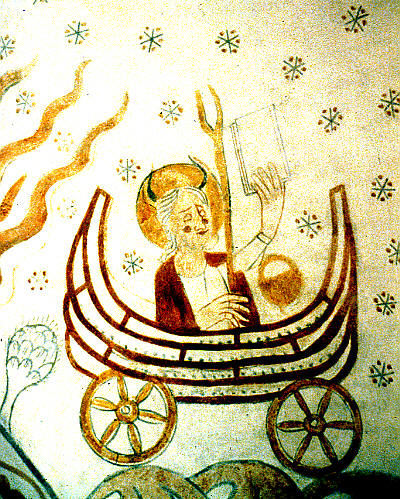 |
| Moses |
| http://www.whale.to/c/moses.html |
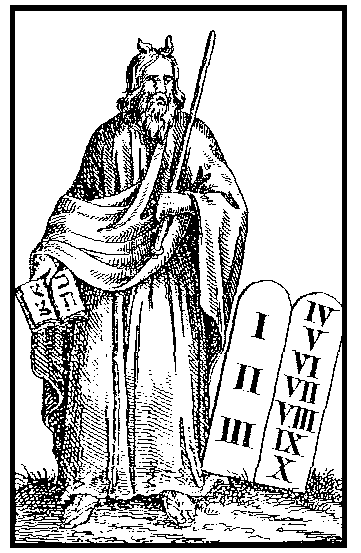 |
| Moses |
| |
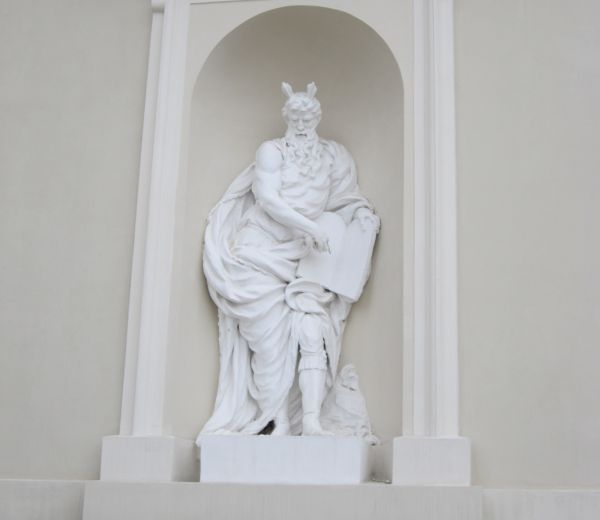 Moses. Statues on the Exterior of the Cathedral. Vilnius. Lithuania |
| https://www.flickr.com/photos/jere7my/4064991041 |
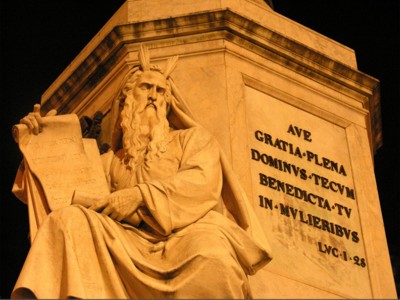 Moses on the Colonna dell'Immacolata |
| |
| http://www.loc.gov/pictures/resource/lambdc.07596/ |
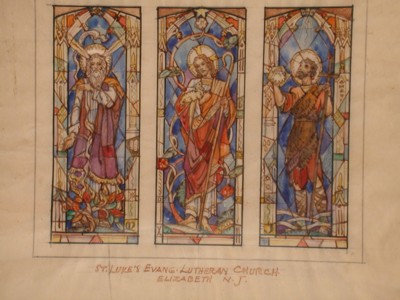 Design drawing for stained glass window showing Moses with "horns" of light and burning bush; Christ with lamb; and John the Baptist with shell for St. Luke's Evang. Lutheran Church in Elizabeth, New Jersey |
| |
| http://chaostrophic.com/10-well-known-mistakes-that-werent-actually-mistakes/ |
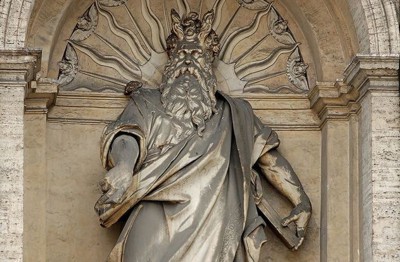 5 Moses Really Was Meant To Have Horns The Mistake: The Vulgate is St. Jerome’s complete retranslation of the Bible from ancient Hebrew to Latin. In one bizarre section, it describes Moses returning from Mount Sinai with a pair of horns on his head. Jerome mistranslated the Hebrew wordkeren (meaning “to radiate light”), resulting in a trend in European art of depicting Moses and other Jews with goat horns. The Reality: The trouble with this story is that it paints Jerome as an uneducated dimwit who just scribbled in a totally out-of-context word and moved on. But in real life, Jerome agonized over his translation, even consulting Jewish scholars of his day. So why did he give Moses horns? The simple answer is he was being faithful to the text. In ancient Hebrew, horns were a widely used metaphor for power. Alexander the Great and Atilla the Hun were both described as “wearing horns.” Because there were no negative connotations, a writer could describe someone having horns as we might describe an authority figure “radiating power.” Just as modern readers would know we didn’t mean they were literally radioactive, ancient readers would have understood the horns were meant to be seen as a symbol of Moses’s God-given authority. |
| 10 well-known mistakes that
weren’t actually mistakes |
| http://ascendedfish.deviantart.com/art/Moses-156408489 |
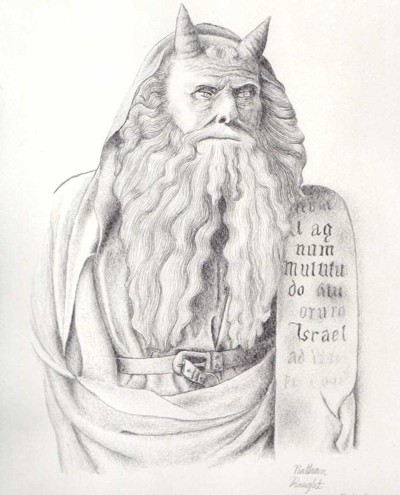 Drawing of Claus Sluter's Moses, which is a statue. Now, you're probably wondering about the horns. Well, the original sculpture has odd bumps on the top of his head. I just made them into something that made more sense: Horns! I have read that in some cultures, horns are a sign of divinity. |
| DeviantArt |
| https://www.pinterest.com/pin/448178600387749696/ |
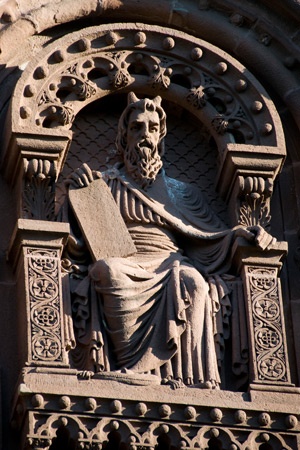 Moses with horns, Princeton University, Princeton New Jersey. |
| |
| http://www.whale.to/c/moses.html |
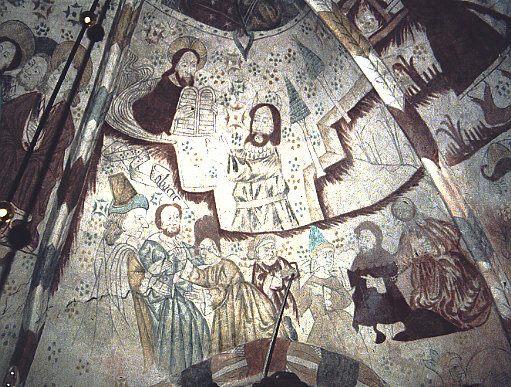 |
| |
| http://www.flickriver.com/photos/theheartindifferentkeys/2382661216/ |
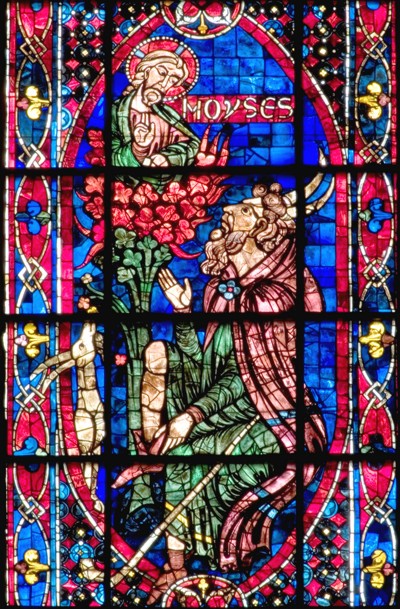 Gothic Window, Chartres, Moses with Horns |
| |
| http://bloglaurabotelho.blogspot.com/2013/11/somos-os-greys-de-amanha.html |
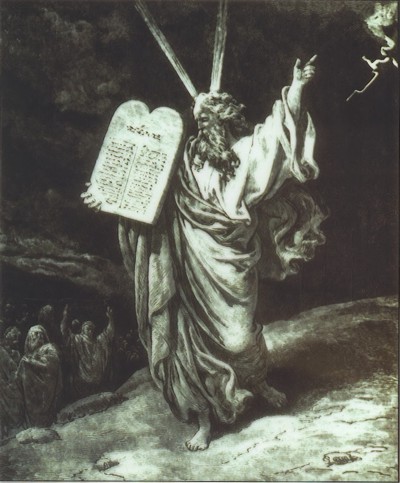 |
| |
| http://kontrowersje.net/tresc/znajomosc_jezyka_potrzebna_od_zaraz |
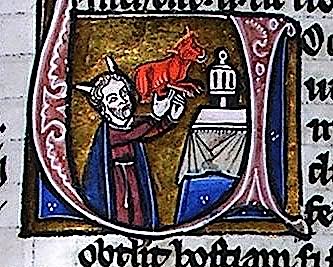 |
| Znajomość języka potrzebna od
zaraz 2009-11-09 |
| http://www.danielmitsui.com/hieronymus/index.blog/1803470/horns-of-moses/ |
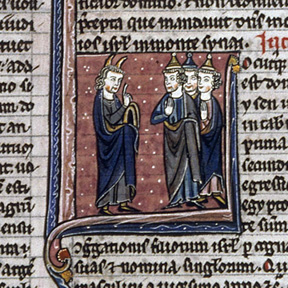 It is commonly known that Moses, in mediaeval art, is depicted with horns on his head. The supposed reason for this is also commonly known; every art history teacher informs his students that the Vulgate Bible contains a mistranslation, which resulted in an absurd artistic convention. I myself am disinclined to think that St. Jerome and centuries of iconographers were all idiots. Upon further investigation, I learned that the Hebrew word - keren - that St. Jerome translated into the Latin as "grew horns" means, literally, "grew horns". His supposed mistake was not knowing that the word also has an idiomatic meaning of "emitted rays of light". Modern scholars, looking at two possible translations for the word, think: Of course! His face began to radiate! How silly that nobody realized this sooner! This provokes from me the question: How exactly are rays of light shooting out of a man's head any more or less plausible than horns growing? I have never seen either happen. They would be equally miraculous phenomena, and I really cannot say which one a multitude of ancient Hebrews would have found more impressive (bear in mind that when God wanted Moses to impress a multitude of ancient Hebrews, He gave him a staff that could turn into a snake). I suspect that several centuries of looking at Baroque and Romantic art have accustomed our minds to imagining rays of light shooting out of things. And cinematic special effects have lately influenced our expectations even more. But projecting those expectations back onto the book of Exodus is snobbery. |
| The lion & the cardinal by
Daniel Mitsui 19 August 2009 |
| http://exviking.net/churches/large/alstadhaug.htm |
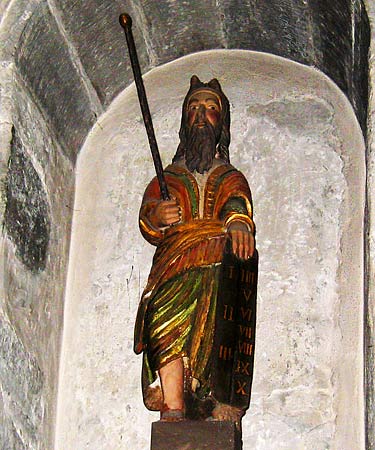 Statue of Moses – with horns – standing in the niche on the right in the fourth picture. The horns are due to a mistranslation from Hebrew to Latin by St. Jerome around AD 400, appearing in what is now known as the Vulgate. In modern bible versions Exodus 34:29–35 says three times that when Moses came down from mount Sinai with the tables, the skin of his face radiated. Simplified, there is a Hebrew word 'qaran' that means 'grow horns' with a derived meaning 'radiate', and St. Jerome might not have been aware of the latter. Various artists have, most kindly, equipped Moses only with modest horns. |
| The Alstadhaug stone church on a beautiful site overlooking a part of Trondheimsfjorden. |
| |
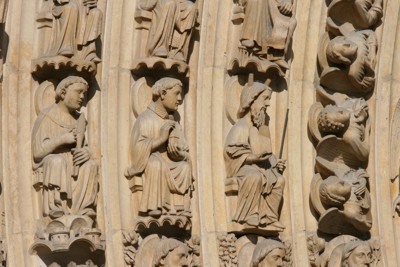 Paris. Notre Dame. Moses with a staff |
| https://www.flickr.com/photos/bnylin/5754418154 |
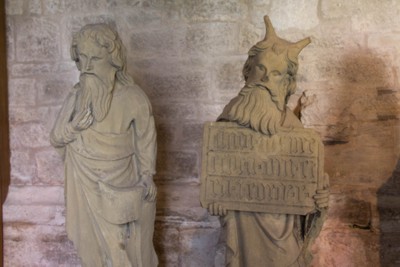 Reichsstadtmuseum, Rothenburg o.d.T. (Moses with horns, due to a mistranslation from Latin) |
| |
| http://schistory.net/springsofgrace3/devotional/Moses/themanitobalegislativebuilding.html |
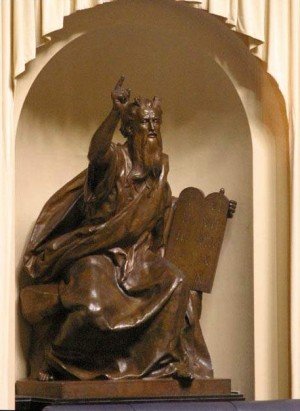 The Manitoba Legislative Building |
| |
| http://schistory.net/springsofgrace3/devotional/Moses/theeinhornunicornpress.html |
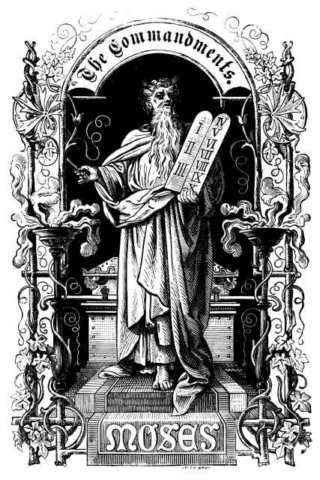 The Einhorn (Unicorn) Press |
| |
| http://specialksplace.blogspot.com/2008_10_01_archive.html |
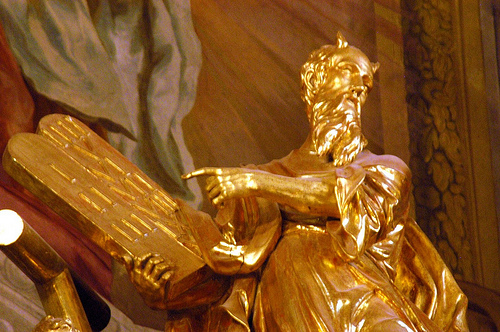 Moses with horns (anyone know why he has horns?) |
| Danube, Part II October 14, 2008 |
| http://blog.spu.edu/lectio/a-merciful-and-gracious-god/ |
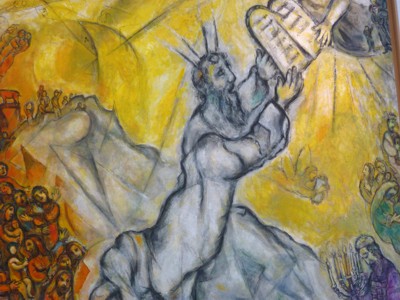 Even in spite of Israel’s unfaithfulness, God proclaims in Exodus 34:6 that God is still, “merciful and gracious, slow to anger, and abounding in steadfast love and faithfulness.” The text continues in verse 8-9 with Moses’ response: “And Moses quickly bowed his head toward the earth, and worshiped. He said, ‘If now I have found favor in your sight, O Lord, I pray, let the Lord go with us. Although this is a stiff-necked people, pardon our iniquity and our sin, and take us for your inheritance.’” Marc Chagall, Moses receiving the law. Musée Marc Chagall, Nice, France. From Art in the Christian Tradition, a project of the Vanderbilt Divinity Library, Nashville, TN. Creative Commons. |
| A Merciful and Gracious God:
Exodus 33–34 By Sara Koenig Seattle Pacific University Assistant Professor of Biblical Studies |
| http://www.faktoider.nu/mose_horn.html |
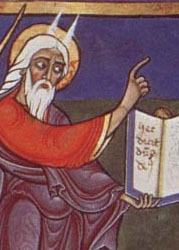 1100-talet: Mäster Hugo |
| Mose horn |
| http://missmeadowsvintagepearls.blogspot.com/2011/11/rouen-part-2.html |
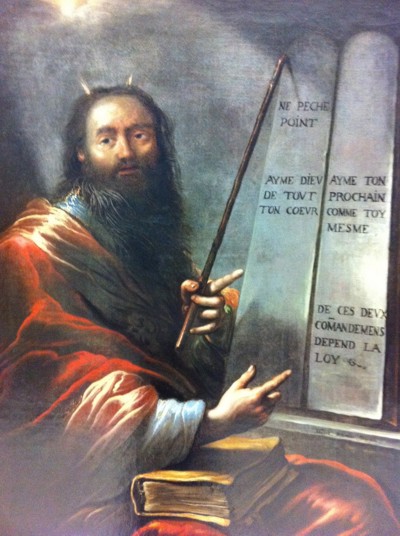 La Musée des Beaux Arts <...> The last painting is depicting Moses receiving the holy commandments. My only question is: "Why does he have horns?". It could be part of the divine light over him, touching his head. But it looks a lot look horns to me... |
| Miss Meadows' Pearls November 16, 2011 |
| http://www.badnewsaboutchristianity.com/aa0_ot.htm |
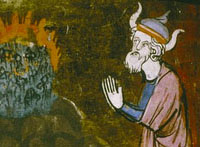 Vulgate <...> Although the Biblewas originally written mainly in Hebrew and Greek, the Western Church ceded primacy to its own translation. St Jerome translated (most of) the Bible into Latin probably between 384 and 404, based on Hebrew and Greek texts, along with earlier Latin translations. His version is the known as Vulgate, so called because it was written as a new vulgar (i.e. common) edition. At the time it was controversial. There were riots over some of Jerome's translations, which were held to amount to tampering with established traditions38. In time it became established not merely as authoritative, but divinely inspired. In 1546 the Council of Trent pronounced the Vulgate to be the only authentic Latin text. It is still considered authoritative on questions of faith and morals by the Roman Catholic Church39. How widely it differs from modern translations (such as the Jerusalem Bible) may be seen by the dual numbering system adopted in the Jerusalem Bible40. We note a couple of errors for historical interest: In Exodus 34:29 the Authorised Version records that when he came down from Mount Sinai " ...Moses wist not that the skin of his face shone ...". This corrects an error in the Vulgate, which records that when Moses came down from the mountain he knew not that there were horns upon his countenance. The problem was caused by the lack of diacritical marks to represent vowel sounds: in Hebrew the words qaran, to shine, and qeren, to bear horns, have exactly the same consonants. St Jerome chose the wrong one and translated it by the Latin cornuta; so, later, did Luther who translated it with the German gehornt. Because of this mistranslation, many of the most famous depictions of Moses show him with a set of horns. The most spectacular examples are the well-known painting by Rembrandt and the statue by Michelangelo. 38 For a few examples where the Masoretic Text varies from the Septuagint see the NIV 1 Samuel 10:1, 2 Samuel 13:34, and Jeremiah 27:1. There are of course thousands of other disagreements. 39 According to St Augustine there were riots in Tripoli over the translation of the Hebrew qiqqayon in the book of Jonah as the Latin hedera (ivy) instead of cucurbita (gourd). 40 According to the Council of Trent God himself was the true author of all the books of the Bible. This was reaffirmed by the papal encyclical Providentissimus deus in 1893. |
| What is so Bad about
Christianity? |
| http://www.sophiaserve.com/2009/09/the-lost-symbol.html |
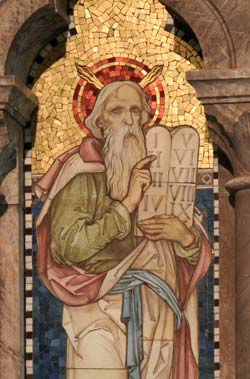 Michelangelo sculpted him that way. Other artists also turned Moses into a Pan or Hermes because of this mistake by Jerome, including this stained glass window in a Welsh church. |
| The Lost Symbol September 23, 2009 |
| http://wordhistories.com/2014/01/15/biblical-translations/ |
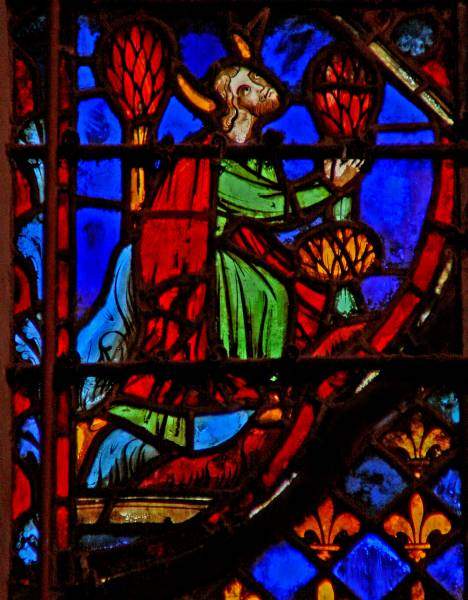 Moses praying Sainte Chapelle – Paris |
| The horns on Moses’ head 15 January 2014 |
| http://www.angelfire.com/folk/cosin/allusions.html |
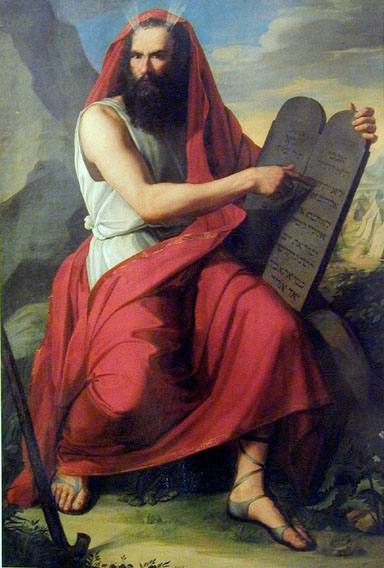 |
| What does Moses say in
Deuteronomy? Biblical Allusions from the Old Testament |
| http://members.bib-arch.org/image.asp?PubID=BSBR&Volume=04&Issue=01&ImageID=03100&SourcePage=publication.asp&UserID=0& http://members.bib-arch.org/publication.asp?PubID=BSBR&Volume=4&Issue=1&ArticleID=9 |
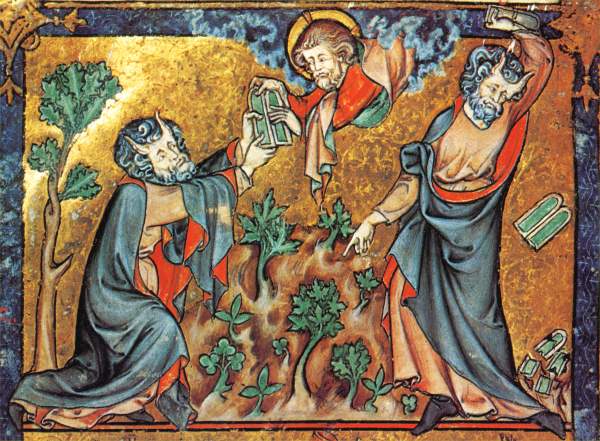  Moses, with a face like a horned mask, upper left, receives the tablets of the Law from God and then shatters them, upper right. In the lower panel of this illumination, the people worship a bright-eyed golden calf. This is a page from a compendium of Church doctrine, dated to c. 1295, entitled La Somme le Roy; it was compiled by the Dominican Frère Laurent for the benefit of Philip III of France. The page shown here comes from the finest copy, illuminated by MaiÆtre Honoré, a leading French Gothic painter. The image of the horned Moses, popular in art for over 900 years, derives from a disputed translation of a single word in Exodus, qaµran. Variously rendered as “horns,”; “horny,”; “was glorified”; or “shone,”; the word that describes the skin of Moses’ face after Moses spoke with God (Exodus 34:29–35) still engenders scholarly debate. |
| Did Moses Have Horns? By William H. Propp 01, February 1988 |
| http://www.whale.to/c/moses.html |
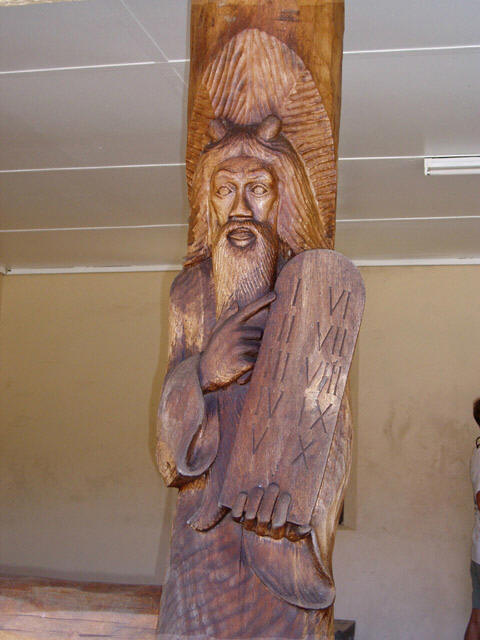 |
| Moses |
| http://www.whale.to/c/moses.html |
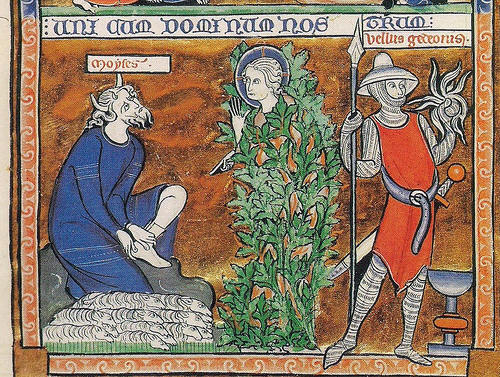 |
| Moses |
| http://www.whale.to/c/moses.html |
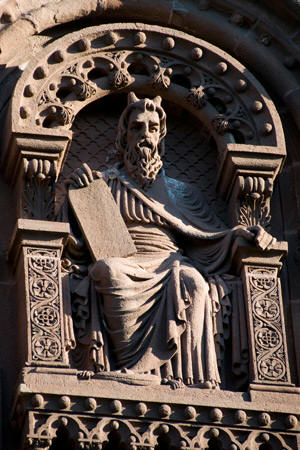 |
| Moses |
| http://www.whale.to/c/moses.html |
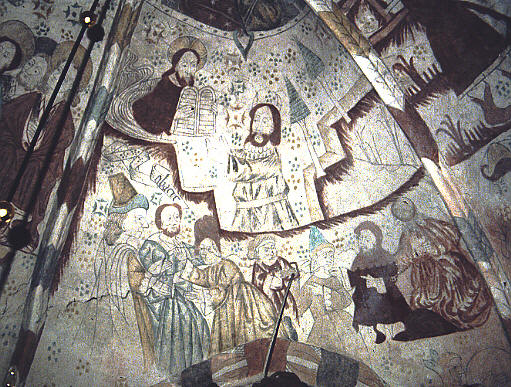 |
| Moses |
| http://www.whale.to/c/moses.html |
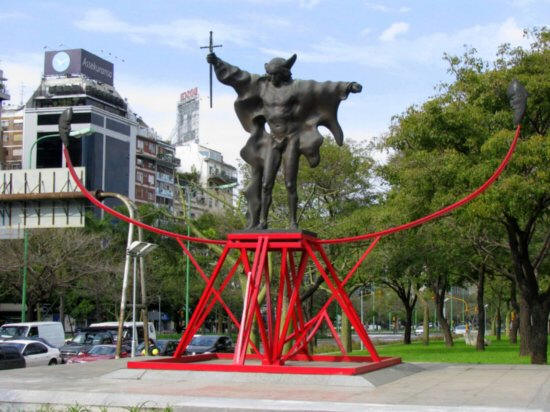 |
| Moses |
| http://www.whale.to/c/moses.html |
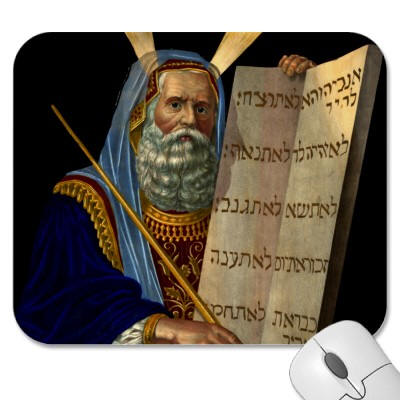 |
| Moses |
| http://www.whale.to/c/moses.html |
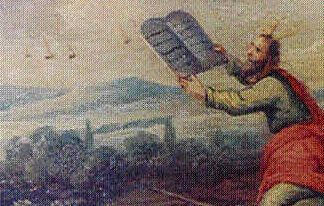 |
| Moses |
| http://www.whale.to/c/moses.html |
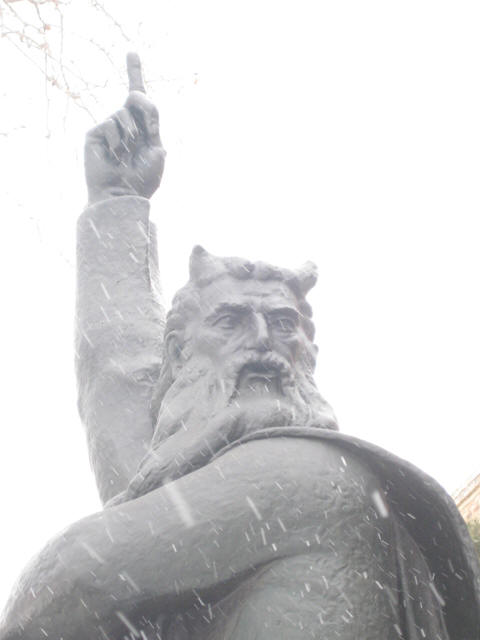 |
| Moses |
| http://www.whale.to/c/moses.html |
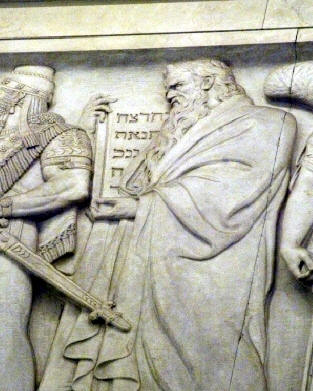 |
| Moses |
| http://www.whale.to/c/moses.html |
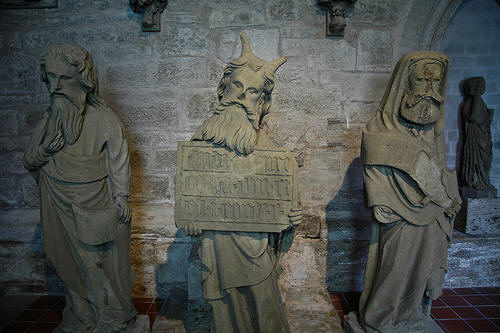 |
| Moses |
| http://www.whale.to/c/moses.html |
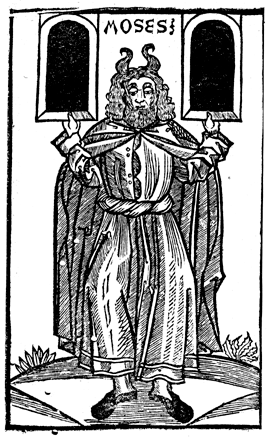 |
| Moses |
| http://www.whale.to/c/moses.html |
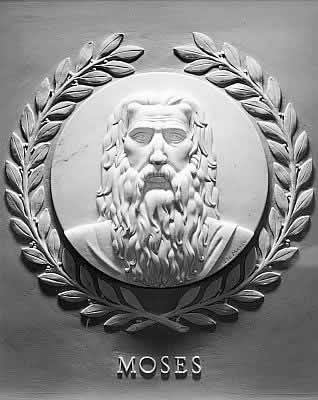 Moses marble bas-relief, one of 23 reliefs of great historical lawgivers in the chamber of the U.S. House of Representatives in the United States Capitol. Sculpted by Jean de Marco in 1950. Diameter 28 inches |
| Moses |
| http://www.whale.to/c/moses.html |
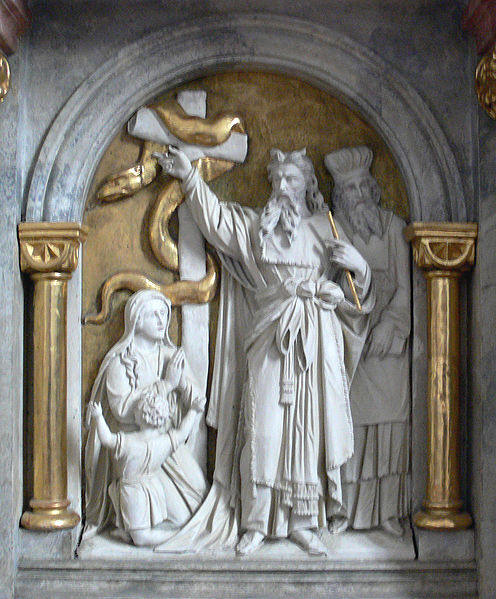 Catholic parish church of St. Vitus in Altmann, Mayrhofen, community of Aichstetten, Ravensburg. High altar, detail: "The Brazen Serpent" |
| Moses |
| http://www.alefpress.org/Articles/index.html |
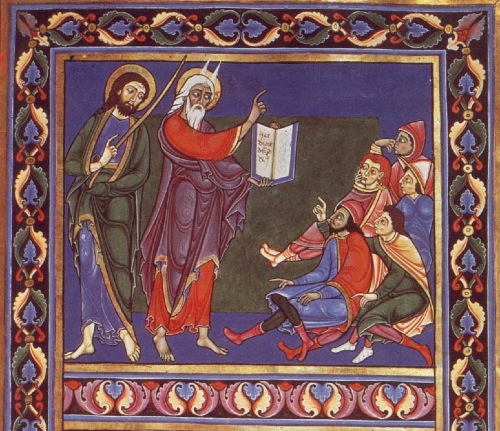 Horns of Light in Bury St. Edmund's Bible, 1135 |
| Why does this man have horns? |
| http://www.alefpress.org/Articles/index.html |
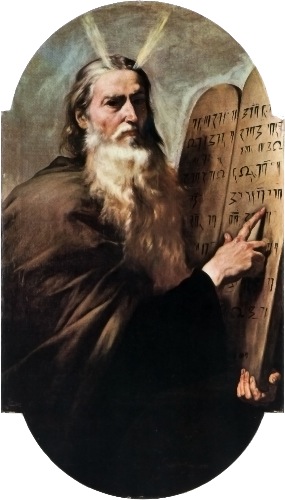 Horns of Light depicted by Jusepe de Rivera, 1638 |
| Why does this man have horns? |
| http://www.alefpress.org/Articles/index.html |
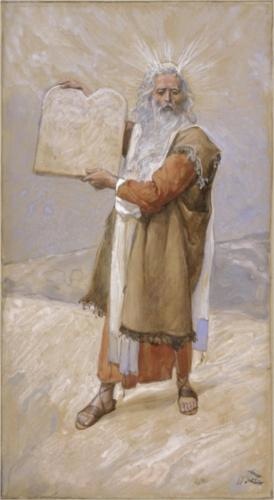 James Tissot's Moses and the Ten Commandments (1902) |
| Why does this man have horns? |
| http://home-plus-art.com/2014/12/04/..... |
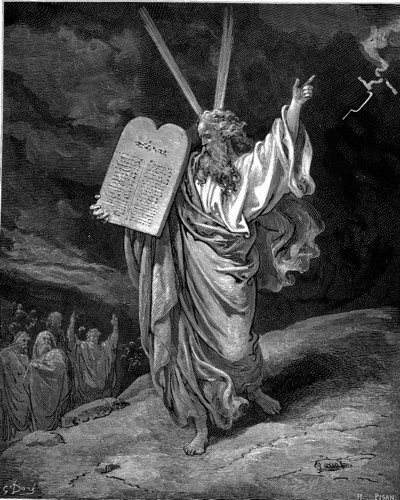 摩西攜帶法版下山,出自朵黑的《聖經插圖》,1865年。在朵黑的插圖 中,他採用類似角的兩道光束來展現摩西的榮光。 |
| http://digi.ub.uni-heidelberg.de/diglit/cpg19/0292 |
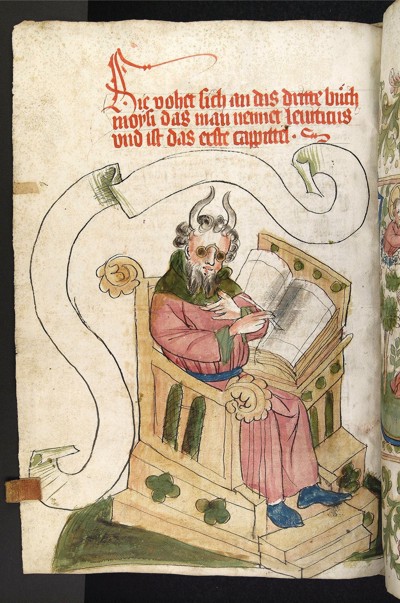 Cod. Pal. germ. 19 Bibel, dt.: AT (Bücher Mose, Josua, Richter) — Hagenau - Werkstatt Diebold Lauber, 1441-1449 |
| Universitätsbibliothek Heidelberg |